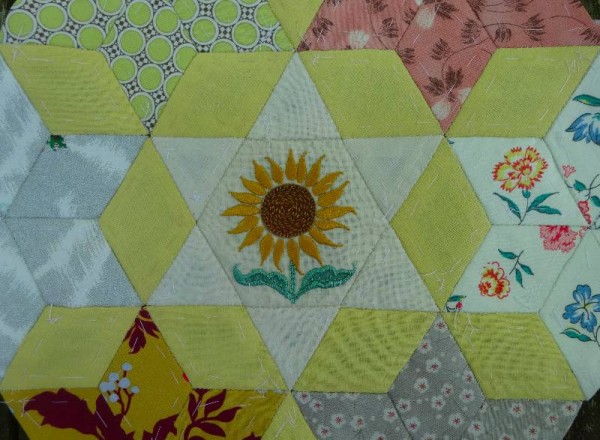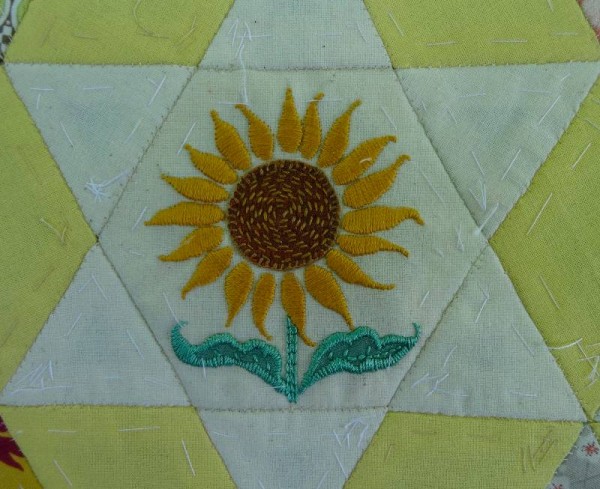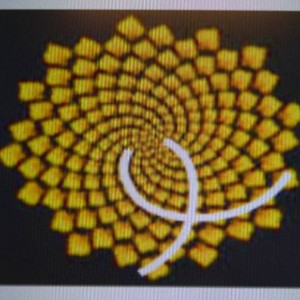
Ipsden Church, Oxon: patchwork altar frontal, detail of sunflower (hand embroidered by Mary Addison)
Hooray, the altar cloth is finished – though I am tempted to add the odd leaf or two to the 1263 that I finished before Christmas. Isn’t that always the way? Meanwhile I managed to slip in a sunflower for the altar frontal. Once again I chose to use appliqué – the centre of the flower is piece of rich brown silk stitched down with buttonhole stitch within which there is a spiral of a simple running stitch, while the leaves are an emerald silk edged in satin stitch; the petals are satin stitch.

Ipsden Church, Oxon: patchwork altar frontal, detail of sunflower (hand embroidered by Mary Addison)
My sunflower is rather sketchy – the head of spiralling florets being a perfect natural example of the Fibonacci Sequence. I would have liked to have shown this better on my sunflower but in a busy week, I decided I could only cope with just so many things and embroidering mathematical fascinations wasn’t one of them.
Briefly, however, (see here) the spiral seen on the sunflower’s head happens naturally as each new cell (destined to become a floret and then a seed) has evolved to form after a turn. This happy genetic accident hit upon the best way of tightly packing a round surface with an optimal number of cells/seeds. If there was no turn the seeds would lie in a straight line and if the turn were a simple fraction, seeds would line up on arms from the centre with lots of gaps between the arms on the flower head – a wasteful use of plant material. Through good fortune, however, the plant has hit upon the Golden Ratio which slips between the distribution of cells/seeds seen with simple fractions and so neatly fills up the flower head with few gaps.
A brief explanation of terms:
2 quantities are defined as being related by the Golden Ratio if their ratio is the same as the ratio of their sum to the larger of the 2 quantities.
The Fibonacci Sequence is: 0,1,1,2,3,5,8,13,21,34,55…(to infinity and beyond as Buzz Lightyear would say).
Now the Golden Ratio and the Fibonacci sequence have a special relationship i.e. any 2 successive Fibonacci numbers have a ratio very close to that of the Golden Ratio.
So, for eg, if a turn of .142857 – or 1/7th – was used you would get 7 arms of cells/seeds on the flower head with lots of space in between.

Diagrammatic distribution of cells/seeds on a sunflower head (from here http://www.mathsisfun.com/numbers/golden-ratio.html)
But if you use the Golden Ratio you get Fibonacci numbers with spiral arms as in the diagram above, where there are 13 arms spiralling one way and 21 the other – go on count them. Now space on the head of the flower is not only used optimally but forms a beautiful and endlessly fascinating pattern. Isn’t that wonderful? I’m glad I took the time to get this straight enough in my mind to write it down, even if embroidering it feels a step too far. With my battery showing red and at one minute past midnight, I should probably finish this post now.

4 Comments
How beautiful your sunflower will be beaming with the warmth and light of summer for all to see.
I have knitted some baby jumpers using the Fibonacci sequence just to play around a little and make the knitting more fun. I am tempted to pick up the embroidery needles but it may have to wait for a little while yet.
Thank you Lydia. The baby jumpers sound lovely – you are obviously a very confident knitter to be able to play around to make knitting more fun!
Mary I really think you have saved the best til last; that sunflower is so full of life and movement; it is absolutely beautiful.
You are very generous with your superlatives, Penny, thank you for being so kind.
2 Trackbacks
[…] If you thirst to revise the fascination of sunflower heads and the layout of their seeds according to the Fibonacci series, do look back to here. […]
[…] the sunflower (cream ground) see here and (black ground) see […]